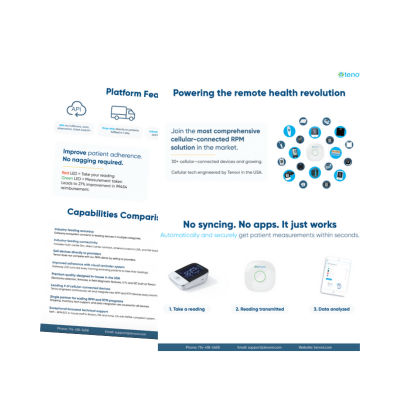Telemedicine and remote patient monitoring (RPM) enable clinicians to stay connected to patients beyond traditional settings. Together, these technologies improve access to care, reduce readmissions, and create more efficient workflows for providers. From chronic disease management to post-acute recovery, research continues to show how connected care supports better outcomes for patients and healthcare systems alike.
This overview highlights peer-reviewed studies exploring how telemedicine and RPM improve early detection, intervention, and ongoing management across diverse conditions. It covers telemedicine research into cancer, cardiovascular disease, and respiratory illness. For more evidence-based insights, visit the Tenovi Blog to explore the latest remote patient monitoring research shaping the future of connected care.
Telemedicine and Remote Patient Monitoring – A Research Review
This research review highlights four peer-reviewed studies that illustrate how telemedicine and RPM are advancing modern care:
- Case Report in Oncology: The Benefit of Telemonitoring in the Prevention of Septic Shock in a Patient with Aggressive Non-Hodgkin’s Lymphoma
- The Impact of Remote Patient Monitoring Devices and Systems on Clinical, Humanistic, and Economic Outcomes in Patients With Cardiovascular Disease
- Data Deluge From Remote Monitoring Of Cardiac Implantable Electronic Devices and the Importance of Clinical Stratification
- Telehealth And Telemedicine in the Management of Adult Patients After Hospitalization for COPD Exacerbation
Case Report in Oncology
A case report in an oncology study demonstrated how telemonitoring can help prevent septic shock in high-risk cancer patients. Telemedicine and remote patient monitoring help patients with life-threatening infections such as sepsis take regular vital sign readings. Thus allowing clinicians to react quickly and help prevent the worsening of symptoms.
A 69-year-old patient with aggressive non-Hodgkin lymphoma used remote monitoring for early infection detection. When fever was identified through RPM, clinicians intervened immediately, preventing progression to septic shock. Upon release, the patient enrolled in remote patient monitoring for early detection of infection. As a result, the patient was admitted again to the hospital within a few hours after the fever was detected with RPM. Furthermore, treatment was started immediately. The authors report that this “illustrates the importance of early detection of infection in high-risk patients, as well as the benefits of telemonitoring. Moreover, avoiding septic shock and the consequent need for intensive care can significantly reduce healthcare costs.”
The Impact of Remote Patient Monitoring Devices and Systems
Telemedicine and remote patient monitoring promise to detect, monitor, and manage cardiovascular disease. The targeted meta-review published on March 5 reviewed 44 studies from January 2017 through February 2022. The goal was to summarize the impact of RPM on clinical, humanistic, and economic outcomes in patients. The authors concluded that RPM technologies support patients with cardiac disorders by improving clinical outcomes and health-related quality of life.
RPM was also found to lessen cardiovascular disease’s economic burden by reducing hospital healthcare resource utilization. Healthcare utilization describes the use of services by people to prevent and cure health problems, promote health maintenance, or obtain information about one’s health status and prognosis.
RPM detected more atrial fibrillation events, was generally more accurate than other monitoring or routine clinical care, and reduced N-terminal-pro hormone B-type natriuretic peptide levels in 95% of patients with heart failure. In addition, RPM significantly improved blood pressure control in 4 of 4 studies assessing blood pressure compared with baseline or engagement with remote patient monitoring.
Data Deluge From Remote Monitoring
https://www.jacc.org/doi/epdf/10.1016/S0735-1097%2823%2902590-1
A study of 32721 patients with cardiac implantable electronic devices (CIED) was published on March 6 by Elsevier on behalf of the American College of Cardiology Foundation. It aimed to quantify the data deluge from CIED, as RPM is the standard of follow-up care for cardiac patients with CIED. The flood of data from remote cardiac monitoring associated with CIED has become a significant challenge for clinicians.
The study’s researchers sought to quantify the data deluge from:
- 14,465 pacemakers
- 8,381 loop recorders
- 5351 cardioverter defibrillators
- 3,531 cardiac resynchronization therapy defibrillators
- 993 cardiac resynchronization therapy pacemakers
Over two years, 384,796 transmissions from all devices were received. The study concluded that remote cardiac implantable monitoring results in much data. However, effective utilization of screening strategies can significantly decrease the burden on providers, thus improving patient care more dynamically.
Telehealth and Telemedicine in Adult Patients After Hospitalization for COPD
The Brazilian Journal of Pulmonology published a review of remote patient monitoring studies in countries including Australia, Italy, Spain, Sweden, the U.K., and the U.S. In recent years, the Brazilian Journal of Pulmonology has played an essential role in disseminating the knowledge produced in the field of respiratory medicine in Brazil and other countries.
In a review of 39 telemedicine and remote patient monitoring studies, the authors reported evidence showing that telehealth, telemedicine, and telemonitoring strategies can benefit COPD patients after hospital discharge. The benefits of RPM were: improving patient quality of life, reducing re-hospitalizations and emergency services, hospital length stay, and health care costs.
Key findings from the article are:
- The majority of telemedicine strategies positively improved health care and quality of life in patients following hospitalization for COPD.
- Telemedicine was effective for early detection and proactive intervention in patients post-acute exacerbation of COPD.
- Adopting telemedicine in everyday clinical practice could substantially improve the care of chronic patients.
For more articles on the latest telemedicine and remote patient monitoring research, visit the Tenovi blog. You can also schedule a free demo and consultation with Tenovi.


